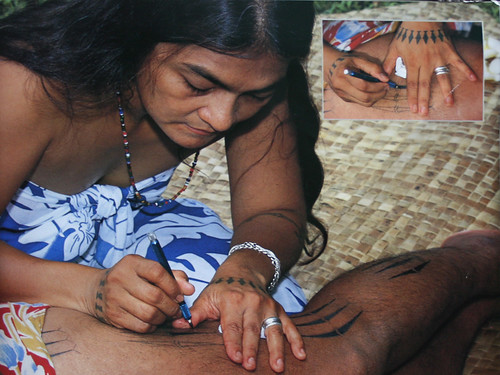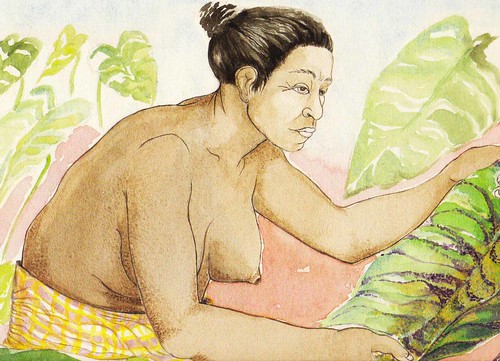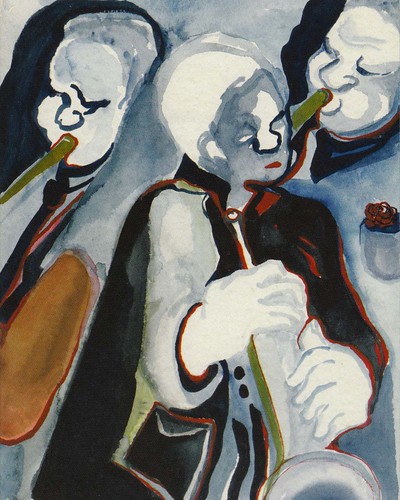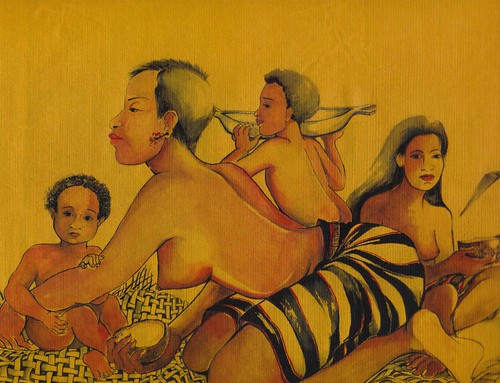Maria Yatar McDonald
Harmonica playing led to life filled with art
Maria Yatar McDonald (1955 – ) is a multi-talented musician, traditional tattoo and visual artist influenced by a wide range of artists beginning with her parents. McDonald was born in 1955 in the village of Pali, Sumai before spending nearly two decades living in the village of Sånta Rita-Sumai, and then in Hågat. She graduated from George Washington High School in 1973 and received a bachelor’s degree in education from the University of Guam in 1997.
McDonald comes from a large family. Her parents, Isidro Ramos and Cecilia Santos Yatar, had 10 children: Nora, Marcella, Luling, Gloria, Helen, Isidro, Vince, Charlene, Anthony and Maria. McDonald’s love for music was nurtured by her parents, who both played the harmonica. She began singing gospel music as a child, performing at family functions while accompanied by her parents as they played their harmonicas. In high school, McDonald and her sister, Helen, along with their cousins Meli Delos Santos and Valerie Cruz, formed a band called “The Chamorettes.” McDonald played the guitar. Her aunt, Josepha Delos Santos, sewed the matching long, flowing island-print dresses the group wore when performing. Her uncle and aunt, Mike and Linda Cruz, were their gospel mentors and also their church-booking agents.
As McDonald grew so did her music repertoire and her ability to play different instruments. Initially, she played the guitar, but over the years she learned to play the accordion, ukelele, penny whistle, nose flute, belembautuyan, and hand percussion instruments such as the shakaree and tambourine.
From her youth, McDonald was largely influenced by musical artists such as Joan Baez, Joni Mitchell, Linda Ronstadt and Dolly Parton during the heyday of American folk and folk-rock. Additionally, while in high school, she and her friends would have impromptu music sessions on the lawn, drawing from the eclectic music program format of Guam’s local radio station that included artists such as Elvis Presley, Martha & the Vandellas, Brook Benton, Woody Guthrie, Bob Dylan and Frank Sinatra, as well as their own personal favorites of The Doors, Led Zepplin, Pink Floyd and Creedence Clearwater Revival.
While living in San Francisco on and off from 1976 to 1990, her appreciation for various musical genres expanded, nurtured by the Bay Area’s musical culture and diversity. She was especially drawn to jazz, specifically the music of Brazilian jazz guitarist Joao Gilberto (probably most widely known for his version of “The Girl from Ipanema”), Brazilian jazz vocalist Flora Purim, American jazz guitarist Stan Getz and jazz vocalist Ella Fitzgerald, as well as the sounds of the Big Band Era. She and about thirteen of her musically-inclined friends created a songwriters guild playing around San Francisco with Glaushaus Productions— a performing arts roaming theater – renting buildings and renovating them for the performances. She played at various venues such as small colleges and business center events around San Francisco, cultural centers in Oakland (she once opened for the Pointers Sisters at a business conference), and at the University of California, Berkeley, coffee houses and art galleries.
In 1992, McDonald and two other well known Guam musicians – bassist Carlos Laguana and conga drummer Rick Sablan – were invited to play at the Vancouver Folk Music Festival. They played alongside American acoustic blues duo Cephas & Wiggins, the Sapphire Sisters, Canadian Cree musician Buffy Sainte-Marie and indigenous Australian musician Archie Roach.
McDonald’s gift for songwriting, storytelling and prose is evident in her original music. Songs such as “Isla Marianas” and “Makpo,” sung in the Chamorro language combine elements of chanting and a hint of jazz and folk. Her life experience – and positive life philosophy – and the Chamorro culture are the material sources that she draws from to compose her music. In “Makpo,” for example, she tells a story of the belief in the suruhana (spiritual healer) and the taotaomo’na (Chamorro ancestral spirits). Her lyrics reflect the way Chamorros negotiate their multiple identies through the interweaving of Catholicism with traditional beliefs, as she asks the Blessed Mother Mary for intercession and help.
Painter and tattoo artist
In addition to her musical talents, McDonald is a proficient visual artist, well known today for her paintings and tattoo artistry. Despite having received no formal training, McDonald has excelled in these endeavors and is largely self-taught. When she was nine years old, McDonald took an interest in painting and was initially helped by an older sister’s boyfriend, who himself was an excellent artist. She was intrigued by his paintings of landscapes like Talo’fo’fo Falls and other Guam scenery. She asked him to teach her to stretch a canvas on a wooden frame and to mix oil paints with turpentine. From then, she never stopped painting and drawing.
Every Christmas she would receive oil painting kits with practice guides for painting horses, wild animals, and landscapes of American historic landmarks like Yellowstone park or the Grand Canyon. Also interested in watercolors, McDonald taught herself this medium and refined her watercolor technique on rag paper when she lived in Berkeley, California. Always busy sketching, painting and drawing, she finally took a pottery class from Dr. Lewis Rifkowitz, a ceramics professor at the University of Guam in 1996. Over time, she pulled 50 pieces of clayware. The largest was a bust of herself that stood two-feet high and was hollow inside like a funeral urn or a large cookie jar.
While living in San Francisco, McDonald spent considerable time working as a researcher for tattoo, particularly Micronesian tattoo, among other things. McDonald also conducted research on tattoo over the years in the Federated States of Micronesia, the Repulic of Belau, and Honiara in the Solomon Islands. She photographed and pencil-sketched elderly tattooed islanders, careful not to photograph those who did not feel comfortable with the camera. Instead they allowed her to sketch their faces and bodywork, after which, she would present her subjects with a photocopy of her work. One noted subject was Isabel Isimong from Belau who was 85 when McDonald sketched her in 1987. She was a “Tatu showcase” in the Pacific Festival of the Arts in Belau in 2008. She also sketched the last Belauan Potter of the Spanish period (Circa 1668-1898), and a heavily tattooed woman from Ontong Java who saved her life and later became her good friend. She also sketched an elderly Yapese woman from the hills of Tomil who became an important contributor to McDonald’s research and eventually, her film project.
Film maker
In 1993 McDonald presented her independently produced film with the School of the Pacific Islands entitled, With the First Canoe: Traditional Tatu of Micronesia, at the Hawai`ian Film Festival, Aotearoa New Zealand Film Festival and the Canadian Edmonton Film Festival. McDonald wrote all of the original music for the video documentary which explores the history of tattoo in Micronesia.
The film was a culmination of her research, but her knowledge and skill in drawing and creating tattoo with traditional implements earned her distinction as a tattoo artist. She received a grant from the Guam Humanities Council to explore Pacific tattoo methods and motifs. Additionally, she was named a Master Tattoo Artist by the Guam Council on the Arts and Humanities Agency (CAHA) Master of Traditional Arts poster series. In April 2011, McDonald was recognized, along with three other distinguished Chamorro artists—master carver Robert Taitano, master weaver Philip Sablan, and blacksmith Joaquin Lujan —as a Master Folk Artist by CAHA. As part of this recognition, McDonald took part in the CAHA Folk and Traditional Arts Apprenticeship Program.
McDonald is married to Dr. Jay Joseph McDonald and together they have a son, Patrick Ciaran McDonald. The family played with a versatile band, “Pago Bay Reefers,” whose music choice is as colorful and talented as the players. The entire band shares in vocal talents and her husband, Jay, plays the fiddle, mandolin, banjo, and harp; their son, Patrick, plays the violin/fiddle. Other members and their instruments were: Dr. Bruce Reynolds on guitar, dobro, and lap steel guitar; Dave Hendricks on guitar and saxophone, Mike Segal on the accordion, guitar and bass and Tim Rohr on drums. The group played a variety of music genres including Blue Grass, Rhythm & Blues, Folk, Rock and Roll, Texas swing, rock classics, and contemporary and whatever else sounds and feels good at the moment.
While McDonald is proficient in music, tattoo and painting she also has other interests highly fueled by her desire to serve her island community. For several years, she taught at Southern High School in Sånta Rita-Sumai, developing a marine biology program centered on Guam’s village fishing culture, before becoming program administrator at the Guam Trades Academy, a nonprofit organization dedicated to providing skills and training to develop Guam’s blue-collar sector.
Music
For further reading
“Guam KAHA. ‘Kahan I Kutturan Guahan’: A Tribute to Masters of Chamorro Tradition.” Pacific Daily News. Last modified 20 December 2002.
Leon-Guerrero, Jillette. Seeing Guam Through Our Eyes. Agana Heights: Guamology Publishing, 2010.







